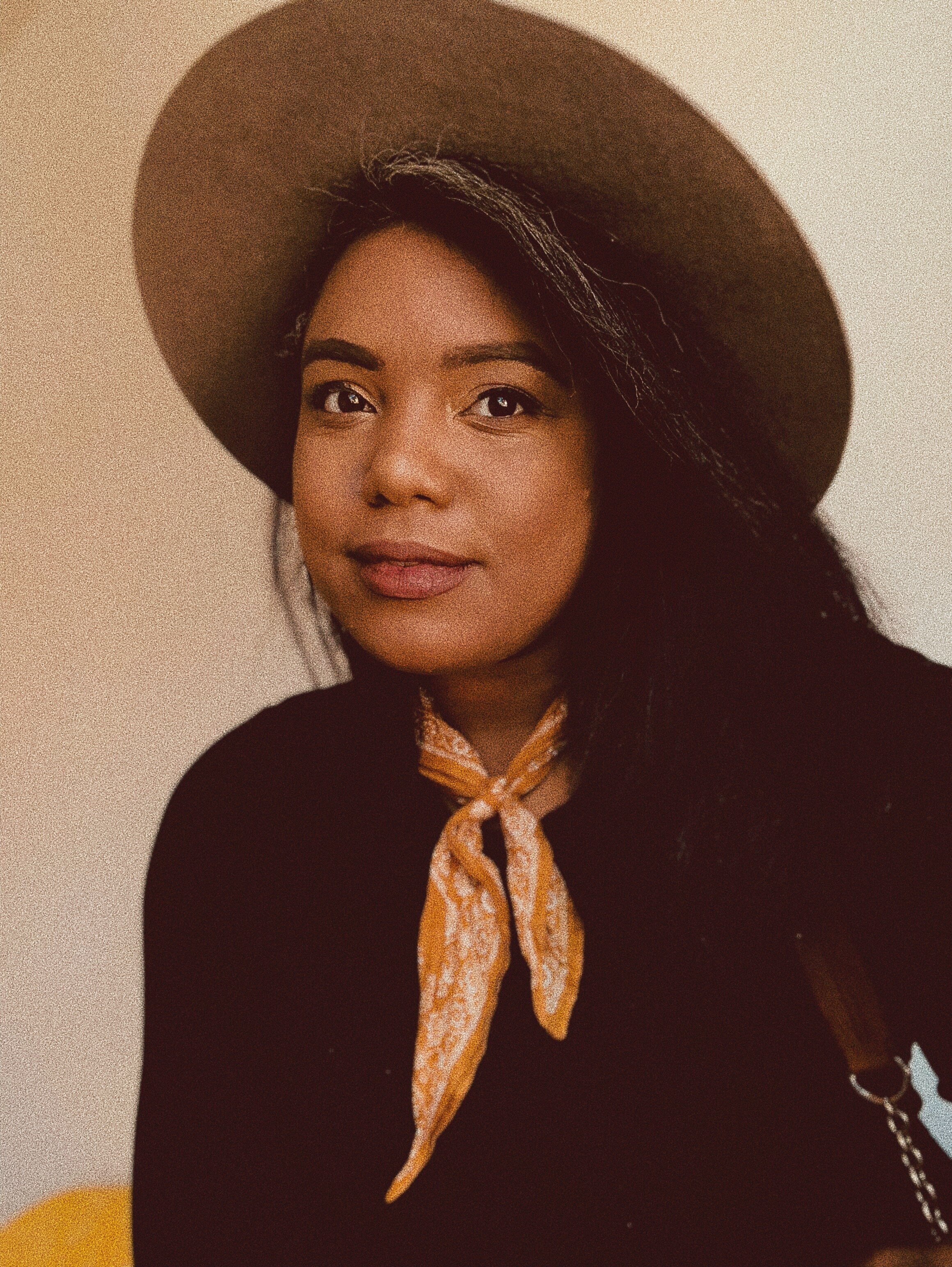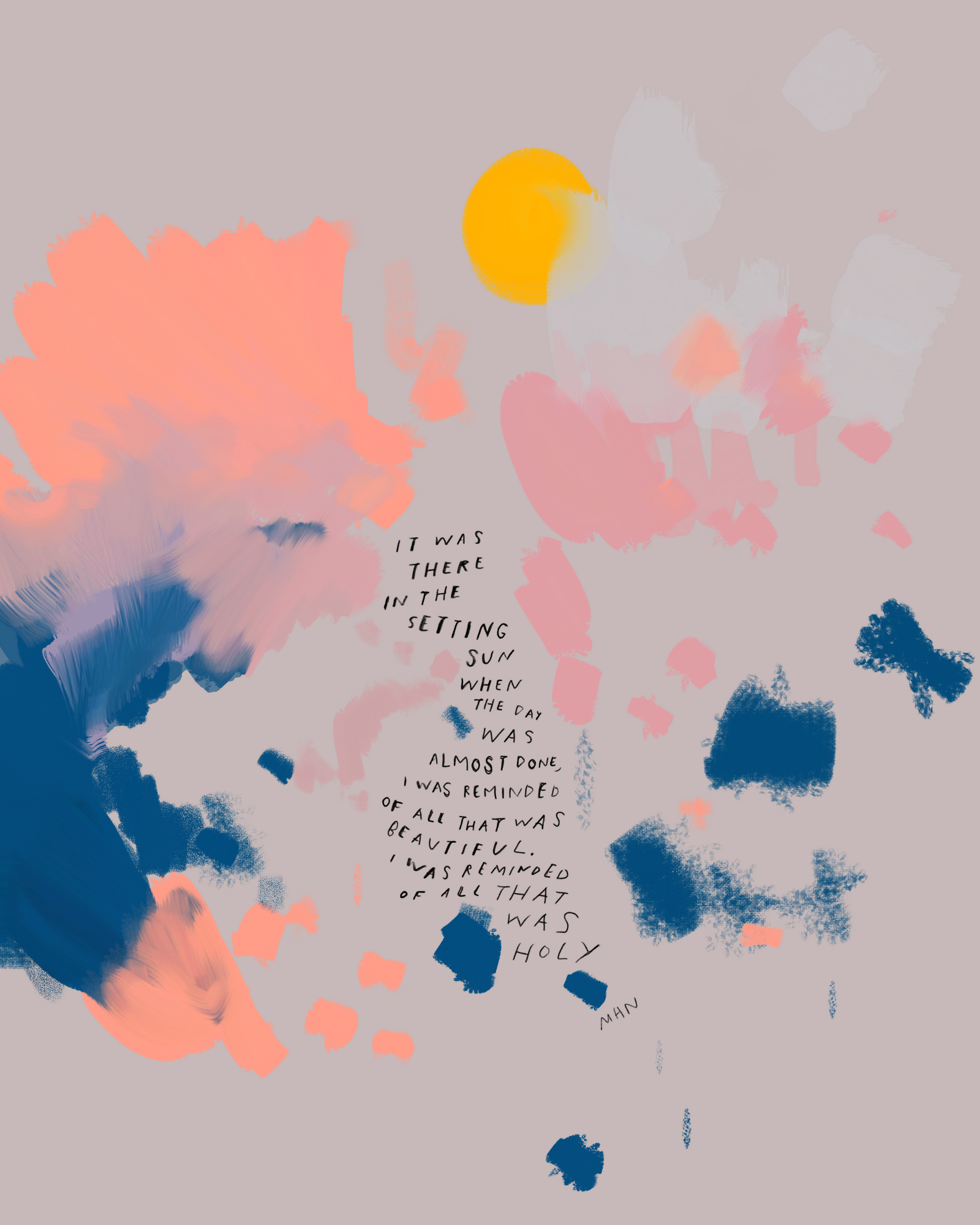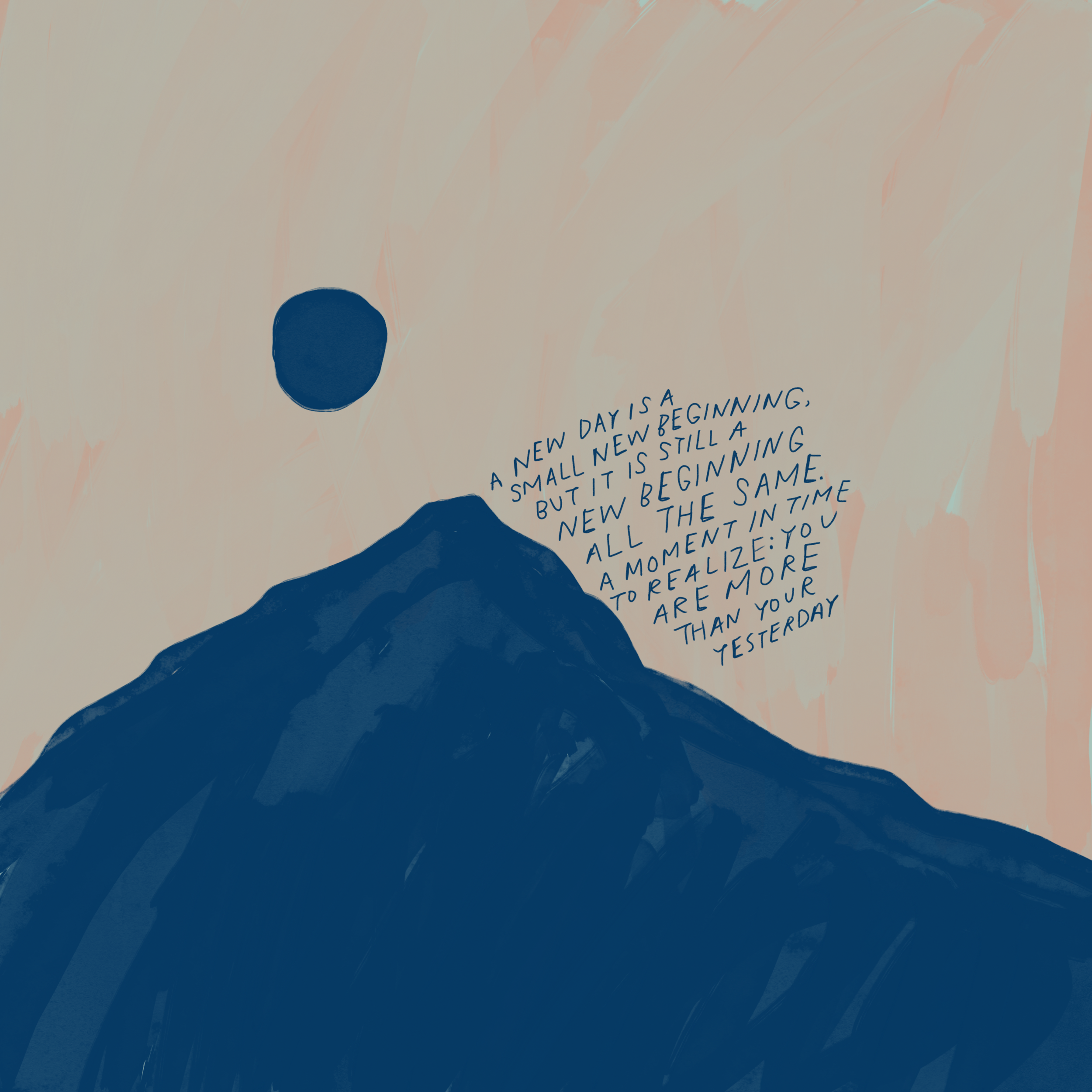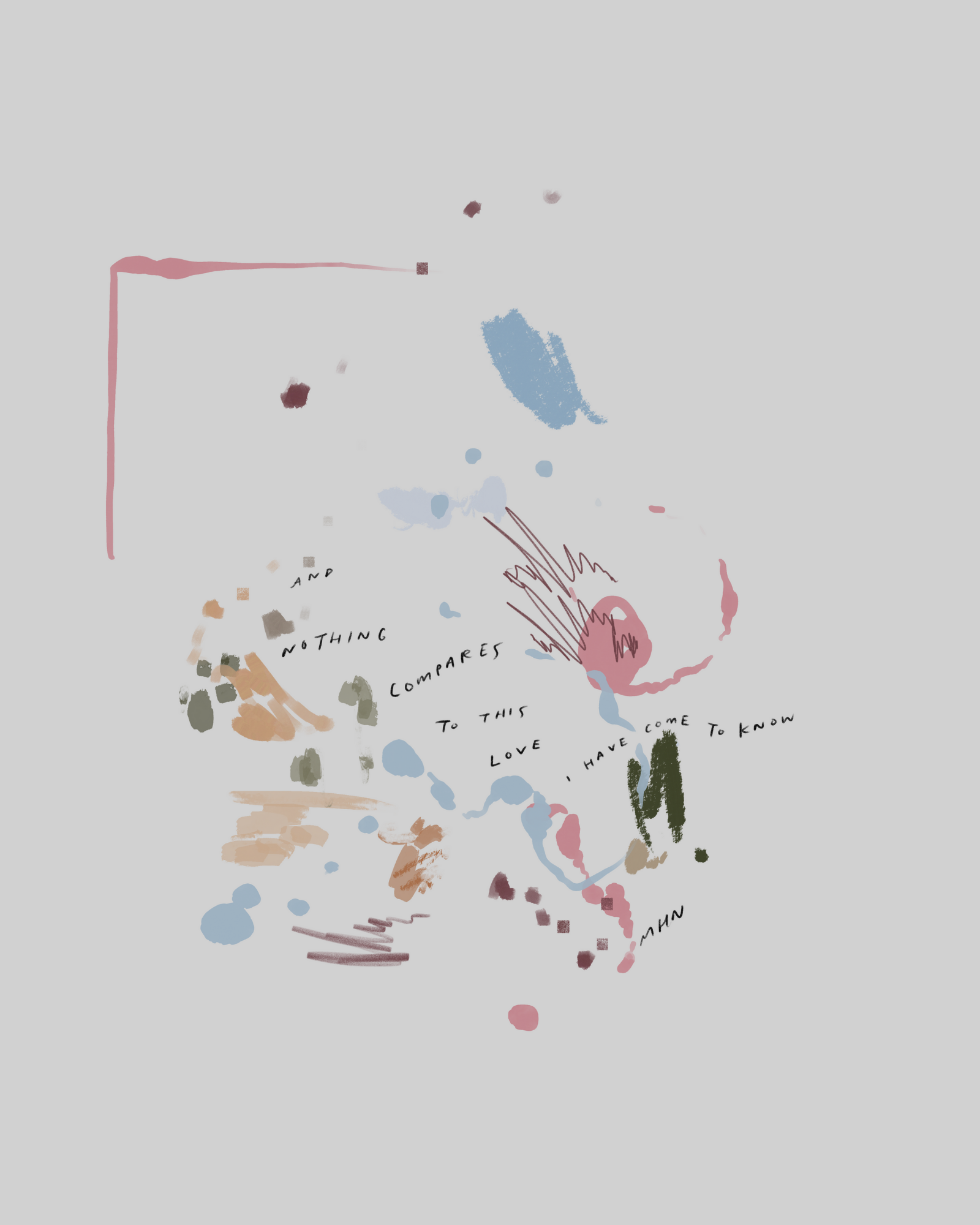Morgan Harper Nichols

Morgan Harper Nichols is a digital artist and poet whose vibrant artwork has nurtured a growing community around her Instagram platform (@morganharpernichols). Delivering messages centering peace, rest, blooming, and more, Morgan combines beautiful illustrations with heartfelt poetry in hopes to spark meaningful dialogues with her audience. In this conversation with FORM, Morgan contextualizes her artistic journey with her sources of inspiration, personal histories, and creative process.
Morgan Harper Nichols: I got into digital art by accident. I've loved art ever since I was a kid. But when I was having some changes with my music career, and I just wasn't making a lot of money, I had to find some other ways to get creative. And I was like, “well, I have this iPad. I guess I could try to make some art.” And it became a curiosity thing. It brought me a lot of calm and peace in a very uncertain time of my 20s. I ended up getting to a really low place where I ended up writing this very vulnerable poem, and I shared the poem on Pinterest. It was actually through Pinterest that my Instagram started to take off, because it ended up getting shared over 100,000 times. It was from there, actually, that people would pin and share my artwork on Pinterest, and then they would start posting it on Instagram. And I was like, “well, I guess I could share on Instagram,” which was just very weird for me. I never thought I would be doing this. And it's been going that way for about three years now. We started selling art prints and stickers, and now it's a full-time job.
Sebin Jeon: It's so interesting how you said that it was something you found during a time of uncertainty and vulnerability, because that's how I felt when I first discovered your work. Some common themes in your pieces include tender reminders that emphasize self growth, peace within uncertainty, and wholeness over perfection. What is your relationship to the messages you share, and where you draw inspiration for them? Where do you find inspiration in general?
MHN: I find inspiration in a lot of places. I just had a very, very colorful childhood. The walls in our house were yellow and red, and my mom was super colorful. My parents are also pastors, and they would have the door open to their house all the time. Not literally, but it felt that way. People would just come in, and it's like, "hey, come over for dinner! Let's talk about things." I saw my parents even outside of the church setting— at home and in the community— just make time for people. That was always special to me.However, I was very introverted. So I always struggled with connecting with people like my parents did. I was just more comfortable writing.
Then the second category: a whole lot of art and a whole lot of poetry. I have so many Pinterest boards, so I'm pinning art all the time. Right next to my computer screen, I have a stack of poetry books. I love reading poetry because you can flip open the book and just read a poem. I don't have a lot of time to sit down and read books front to back like I want to, so other mediums have been influential for me: podcasts, poetry books, audio books, and just real interactions with people. I make my artwork inspired by stories people send me. I'll put a question on my Instagram story, and people answer that question, and then I'll write a poem to their answer.
There are all these poetic moments that happen in our daily conversations with each other, and we forget about them. I try to find real moments when I even just say to someone, “I'm sorry you're going through that, and it's going to be okay.” Just that alone, to me, feels like poetry. So, I try to tap into that. I get inspired by a lot of things—and nature! I didn't even say anything about nature! I love the outdoors. I live in Arizona now, and I can see mountains from my window, which is so beautiful.
Bella Bann: I did a missions program for a year with an organization called YWAM (Youth With A Mission). Many of the young adults and missionaries there repost your work and mention you in preaches and devotions. They're super similar to some of the verses my mom sends me. If you do have a religious background, how do you navigate that in a platform like Instagram, that may not always uphold the same beliefs?
MHN: As I mentioned, I grew up in the Christian tradition that is very rooted in the African American descendants of slaves church, and I'm still a Christian to this day. It's been very interesting, though, because with this tension of struggling with some. When I got to college, I would interact with people whose Christianity looked a little bit different than mine and how I grew up, and theirs was a bit more like mega churches. I grew up in a church with like 100 people where church was this thing that was integrated into the community. And it was what you talked about. When you are a person of faith, and it's in a small church in a small community, it is very integrated into daily life. We're a part of this community.
This might sound weird to some people. But for me, I feel like I'm always in conversation with God. And it's sometimes the word God will appear in the poem, and it happens naturally. I do get some people who get frustrated. Sadly, it is Christians a lot of times. And I totally understand if you're looking for a Bible verse, and go do that! Go read a Bible verse if you need that, but art unfolds differently. And that's how it's naturally unfolding for me this season of my life.
SJ: That was a question I also had for a really long time. When I was in a rough part of my spiritual journey earlier this year, I saw a lot of your posts about light. I couldn't help but feel like there was something deeply spiritual about them. It resonated so much with me that I was wondering if you were a faith-based artist, so that's really cool.
MHN: Well, I'm so glad you felt connected to it in that way, because that's definitely my goal. I feel like a lot of people may struggle to feel connected with God, because it's like, "well, I can't see God." So for me, I'm like: we have this beautiful bright sun every day. To me, that's a reminder of the presence of God. That's why I love to speak about nature and light in that way. I may not know how God's speaking to me, but I know what light looks like. I know what light feels like in my life. My hope is always that people can hear those words. Then it helps them connect the dots. I got a message from someone one time, and they said, "I don't know why. But there's something about your poetry that made me pray today, and I've never prayed before in my life."
That's why I do what I do. I'm okay with the person who's like, "this isn't enough of this for me." It's okay. They’ll find something else. But I am grateful for those moments. I still get chills when I think about that story.
SJ: I started following you in the beginning of 2020, but I know that you've been advocating for rest and slowing down way before the pandemic and this greater awakening to systemic racism and racial violence. How have these especially confusing times impacted your work and how people respond to it?
MHN: In so many ways, becoming an artist that has followers and a book can be very intimidating. There are still times where I think about it, and I'm like, "Oh, my gosh, how did this happen? This is too many people." But in many ways, I am writing to myself. I am still writing to different parts of my story. When I was a sophomore in college, that was a really weird year. You're not an upperclassman yet, but you're not a freshman. I transferred schools in the middle of the year and changed my major. There was just so much going on, and I still feel like, in many ways, I'm writing to that version of Morgan. And that version of Morgan dealt with racism in college. That version of Morgan dealt with sexism and rude guys and people who were having little cliques, and I felt left out.
So when I'm writing “take time to rest” and “you don't have to sort through everything tonight,” I'm still writing for her. I remember when I was a junior. When I was a junior, Obama was elected. The polarization on campus was just unbelievable. Overnight, people who I would talk to suddenly felt really uncomfortable that there was a Black president coming. I just wanted to be like, “why can't you just disagree without feeling this hatred?” And it really perplexed me, and it made me feel very frustrated, upset, and confused.
A lot of people still feel like that today. That's the stuff that I feel is timeless. Americans tend to think of things in the election cycle mindset. There's a much larger timeline, and there's so many new things that we're feeling now. Yes, 2020 is weird. It is like no other year, but a lot of the anxieties and oppression and racism is coming up now. It's not new to 2020. We may still be dealing with this in another four years, or another eight years. I think that's why I keep coming back to those themes. It's something that now that I'm 30, I still need to hear. And as it turns out, a lot of other people feel that way too. We're all doing our best right now. We're all trying to be good friends. We're all trying to be our best. And at the same time, we still need to take time to rest.
SJ: I've also been looking on accounts like The Nap Ministry, which advocates for rest as resistance. Finding those alignments in your work has been a huge source of comfort for me and navigating not only these times, but times before the pandemic.
BB: What does your creative process look like, moving from ideas to the final creative project?
MHN: I actually started out with the Adobe apps, so Adobe Sketch. Now, I primarily use Adobe, and Procreate as well. I try to make the art first. There's something about making art that calms you. It can bring you out of all the anxieties, and you're just focusing on that thing. For some reason, writing isn't like that for me. I get in my head way too fast, way too much. I like not having to worry about the words and being able to play with colors and paint flowers and mountains. There's just something about that that's just like, “okay, I don't have to work right now. I can just move my hand and create circles.” If you see my art, it's pretty simple. I'm not really doing incredibly detailed work. I mean, it's a lot of detail, but I can do it passively. I can just paint. What I love about digital is that I can make a mistake and undo it.
That's actually how I start the day. Then, I let the peace tell me what kind of words need to be on it. For instance, anytime I start getting into yellows, I start writing about courage. When I'm writing for other people and if someone sent me a story, colors just pop in my mind. I would start thinking green, and I try not to question it. I go for it. As I start painting, the words usually come, and sometimes it's nothing more than “rest” or “breathe” or “trust.” And sometimes it's a whole paragraph.
Another technical thing is that I always keep the text layers separate from the art layers, because typos happen. I did that today, actually. I was like "oh, I really like this," but there was a major typo in it, so I went back and fixed it. And then sometimes, I think that I want the words to be different on the piece, so I'll make that adjustment.
BB: What would your advice be for aspiring artists, writers, or even students who are in school but have no clue what they want to do in life? I personally have loved art forever, but sometimes I feel discouraged, because in my family, it's not viewed as the successful path. How would you navigate that confusion? What would be your advice?
MHN: I've been thinking about that a lot lately. How did this happen? When I started to do art, I was still doing tons of freelance work to pay the bills. My husband was also in tons of freelance work, and I was exhausted. How did I make all this art? And I think that for the first time in my life, I found this creative endeavor that brought me peace. I could do it even when I was tired, and there are some things I can't do when I'm tired. For instance, I can't make music when I'm tired. That's just how I'm wired. Some people aren't like that. My sister is the total opposite. But with art, even when I've had a long day, and even when I'm tired, and overwhelmed, for some reason, I (inaudible) on this page.
Even if you're majoring in accounting, but you have in the back of your mind like, “I don't know, maybe I can be an artist. Maybe this is something I want to do,” I would say to find an art form that you can do even if you don't have all the energy that you want to have. For some people, that's just photographing nature. And I think that's huge, because you're a college student, you have a lot on your plate, and you don't have a lot of days where you’re well slept and your schedule is clear. It's important to have things that you can squeeze in. The second thing is to create. It doesn't have to be your main Instagram or anything, because that can be intimidating. But create a Pinterest where all you do is just upload your art. You don't even have to tell anybody about it. Just upload your art, put a whole bunch of hashtags on it, and let it be.
The best thing about being young is that you can build up that portfolio and repertoire and allow yourself to be surprised by the people who end up finding it. I remember when I got my first commission. I was so shocked, because they were like, “we want you to design some cards for a youth group function.” And I was like, “you're paying me to do it? This is crazy.” It totally caught me by surprise. I didn't have anything on my website about rights. None of that. I didn't know any of that worked. And yet, someone was willing to pay me, because they liked my style. I definitely think that you should find something, and it's different for everybody. It doesn't mean it's the only thing you ever do. You could focus on photography, and then years from now you're a filmmaker or a textile designer. Who knows? I think it's important to have a creative practice that you can do in small glimpses even if you don't have a ton of time and energy.
SJ: There are many themes in your artwork that are about slowing down, letting go, and healing. What kind of conversations are you hoping to start with your art as you move forward?
MHN: That's such a good question. I feel like I've learned from listening, responding to DMs, and reading people's comments that people have so many different stories. We're on the internet, and it's sometimes hard to see, because all we're getting is profile pictures and usernames. But these are really complex, unique stories, contexts, and cultures, and I don't know the ins and outs. What I hope to do is use the kind of language that helps people start a conversation with themselves, God, and people in their lives who they want to connect with on a deeper level. I'm okay if people talk to me, but at the end of the day, we don't know each other. There are people in your life who you may desire to connect with more, or parts of yourself that you decide to connect with more.
I want to start telling others to use my art as journal prompts if it immediately makes them think on their own or how they would have said it differently. You've been prompted. If you're wondering what inspiration looks like, it just happened. That's how it happens. I think that is one of the best things that can happen, because it's easier to pay attention to the negative voices and thoughts in our heads that tell us that our ideas aren't valid, or that it's not that big of a deal. I want to encourage people to start paying attention to their unique voice, because that's made such a difference in my life. The fact that I now have artwork that I can look at when I’m feeling discouraged and say, "oh, wow, I have created that. I have done that," makes a huge difference in my life. I definitely want to help other people cultivate that.
BB: Are there other artists that you love and creators that you look up to?
MHN: Yes. Oh my gosh, there are so many. I'll go grab one just to show you guys. This is one of my favorites. Her name is Corita Kent. She was actually a Catholic nun and college professor. As an art teacher she would take things like the Wonderbread logo for bread and turn it into, "This is the living bread." She would take lyrics from Beatles songs and turn them into pieces. She did a lot of social justice and powerful work. One day, I realized I kept pinning her work on Pinterest, and I didn't realize it was the same person. I looked her up, and she had a very similar idea. She was Catholic, she was a Christian. At the same time, so much of her work was like: how can it connect to people who are different from her? How can it look like something that would be on a billboard? She's one of my favorites.
A lot of the artists that I follow have passed away. Another one is Hilma af Klint, and she was a Swedish abstract artist. What I love about her is that she was actually one of the first people to make abstract art in the West. However, she's not given credit in a lot of the traditional art history world, because there were some other guys who did it. A lot of women are underappreciated. If you Google “Hilma af Klint,” you'll see how gorgeous it is. If you look at her work, it's like, “wow, here's someone who really gave her all, and she never even lived to see the fruit of it.” She never knew the impact of her work. I was watching a documentary, and they were talking about the first time they did a showing of her artwork in Sweden. People are walking in there crying. That's how connected they felt to her artwork. And to think that she never lived to see people connect with her in that way. I always have to remind myself of that, because I also notice if a post didn't get as many likes. I have to remind myself that there's a much bigger picture. The third one is Faith Ringgold, an African American quilts maker. She puts these beautiful stories into quilts. It's so powerful, because it's so colorful and beautiful, but the more time you spend with it, the more time you see the really rich narratives.
BB: Are there any upcoming projects that you're working on or maybe that you're excited for?
MHN: We did this calendar for next year which I'm super excited about. This is really special, because it's the first time that we designed our own product. We have an online store, and my husband is the one that does the business side of it. We've been doing prints and had a calendar last year. We had this idea: what if we did a calendar where you could tear off the artwork when the month is done? So that's how the calendar goes. It's perforated right there, so you get 12 art prints from it. I'm super excited about that, because it's very hard for me to see my artwork as products. I just don't see it that way, so I always get excited when other people either present me with an idea or I finally think of something. I also have a new book coming out in March, which feels like forever away. It’s going to be similar to the one that I have out now, but it's going to have a few more essays. I talk more about my personal story and growing up.
BB: Well, I'll be first in line.
MHN: Oh, thank you, thank you. I really wrote it with college students in mind. I really did, because two of the essays are about when I was in college. I talked about when I failed biology and how I recovered. Then I have a friendship story about like five friends that abandon me on a trip. A lot of college stuff in there.
BB:Thank you so much, this has been the highlight of my semester.
MHN: Thank you. You have a great rest of your day.





